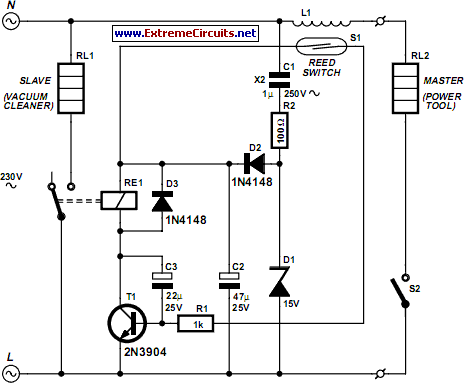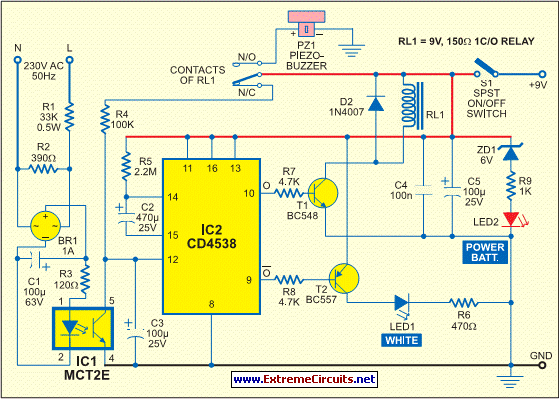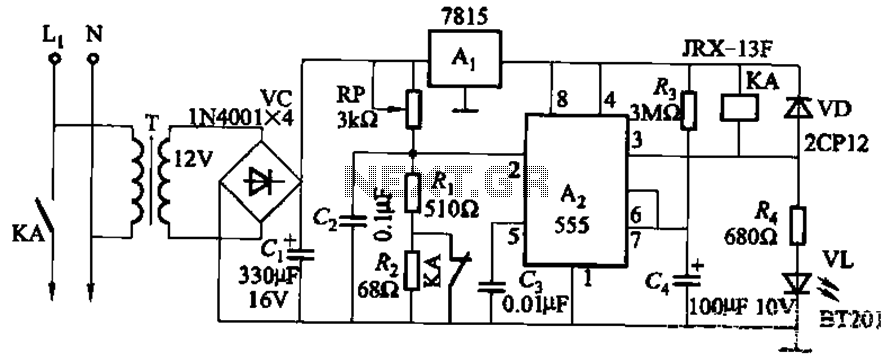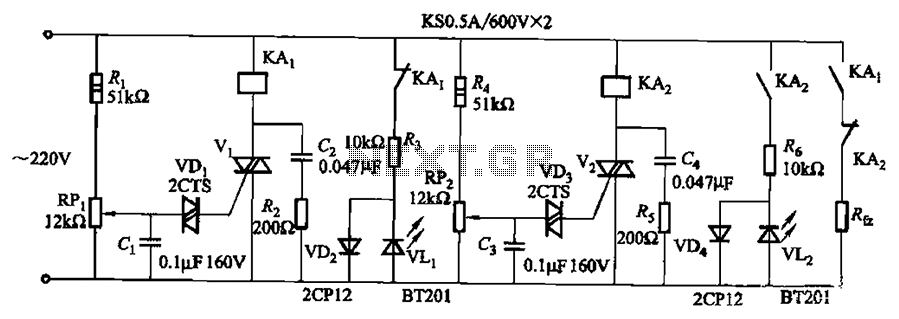
Mains Slave Switcher II

A one-inch reed switch with 40 turns effectively activates with the current flowing through a 150-watt lamp (approximately 625 mA), though larger reed switches may necessitate additional turns. If the master appliance draws less current, which is uncommon for power tools, more turns will be required. The reed switch is utilized to activate transistor T1, which subsequently switches relay RE1 to power the slave appliance. Due to their low mechanical inertia, reed switches can easily respond to fluctuations in the magnetic field caused by the alternating current in the coil, allowing them to switch on and off at 100 Hz. Capacitor C3 is included to delay the transistor's response, ensuring the relay remains energized during the zero crossings of the mains when the current drawn by the appliance drops to zero and the reed switch opens. Capacitor C1 reduces the mains voltage to approximately 15 V, as determined by zener diode D1, and this voltage is rectified and smoothed by diode D2 and capacitor C2 to provide a direct current supply for the circuit. The relay contacts must be rated to handle the intended appliance (e.g., vacuum cleaner), and the coil should possess a minimum resistance of 400 ohms, as the simple direct current supply can only deliver a limited current. Capacitor C1 drops nearly the entire mains voltage and should be an X2-class component with a voltage rating of at least 250 V AC. Given that the circuit is directly connected to the mains supply, careful construction is essential, and the circuit should be housed in a plastic or earthed metal enclosure with mains sockets for both the master and slave appliances.
The described circuit utilizes a reed switch to control a relay via a transistor, enabling the operation of a secondary appliance based on the current drawn by a primary device. The reed switch's ability to respond to AC fluctuations ensures reliable operation, particularly in applications involving power tools that may have variable current draw. The inclusion of C3 serves to mitigate potential rapid on-off cycling of the relay, allowing for smoother operation during the zero crossings of the AC waveform. The power supply section, consisting of C1, D1, D2, and C2, is critical in converting the high-voltage AC mains into a usable low-voltage DC supply for the circuit's components.
Safety is paramount in this design due to its direct connection to mains voltage. The use of an X2-class capacitor for C1 is crucial, as it ensures the component can withstand the high voltage and potential surges present in the mains supply. The relay's coil resistance specification ensures that it operates within the limitations of the power supply, preventing overheating or failure. The enclosure design must also consider grounding and insulation to protect users from electrical hazards. Overall, this circuit represents a robust solution for controlling high-power appliances while maintaining safety and reliability.As a guide, a one-inch reed switch with 40 turns reliably switched on with the current flowing through a 150-watt lamp (approx. 625 mA) but larger reeds may require more turns. If the master appliance draws less current (which is unlikely with power tools) more turns will be required.
The reed switch is used to switch on transistor T1 which in tur n switches the relay RE1 and powers the slave appliance. Since reed switches have a low mechanical inertia, they have little difficulty in following the fluctuations of the magnetic field due to the alternating current in the coil and this means that they will switch on and off at 100 Hz. C3 is therefore fitted to slow down the transistor response and keep the relay energised during the mains zero crossings when the current drawn by the appliance falls to zero and the reed switch opens.
C1 drops the mains voltage to about 15 V (determined by zener diode D1) and this is rectified and smoothed by D2 and C2 to provide a d. c. supply for the circuit. The relay contacts should be rated to switch the intended appliance (vacuum cleaner) and the coil should have a minimum coil resistance of 400 R as the simple d.
c. supply can only provide a limited current. C1 drops virtually the full mains voltage and should therefore be a n X2-class component with a voltage rating of at least 250V a. c. The circuit is by its nature connected directly to the mains supply. Great care should therefore be taken in its construction and the circuit should be enclosed in a plastic or earthed metal box with mains sockets fitted for the master and slave appliances.
🔗 External reference
The described circuit utilizes a reed switch to control a relay via a transistor, enabling the operation of a secondary appliance based on the current drawn by a primary device. The reed switch's ability to respond to AC fluctuations ensures reliable operation, particularly in applications involving power tools that may have variable current draw. The inclusion of C3 serves to mitigate potential rapid on-off cycling of the relay, allowing for smoother operation during the zero crossings of the AC waveform. The power supply section, consisting of C1, D1, D2, and C2, is critical in converting the high-voltage AC mains into a usable low-voltage DC supply for the circuit's components.
Safety is paramount in this design due to its direct connection to mains voltage. The use of an X2-class capacitor for C1 is crucial, as it ensures the component can withstand the high voltage and potential surges present in the mains supply. The relay's coil resistance specification ensures that it operates within the limitations of the power supply, preventing overheating or failure. The enclosure design must also consider grounding and insulation to protect users from electrical hazards. Overall, this circuit represents a robust solution for controlling high-power appliances while maintaining safety and reliability.As a guide, a one-inch reed switch with 40 turns reliably switched on with the current flowing through a 150-watt lamp (approx. 625 mA) but larger reeds may require more turns. If the master appliance draws less current (which is unlikely with power tools) more turns will be required.
The reed switch is used to switch on transistor T1 which in tur n switches the relay RE1 and powers the slave appliance. Since reed switches have a low mechanical inertia, they have little difficulty in following the fluctuations of the magnetic field due to the alternating current in the coil and this means that they will switch on and off at 100 Hz. C3 is therefore fitted to slow down the transistor response and keep the relay energised during the mains zero crossings when the current drawn by the appliance falls to zero and the reed switch opens.
C1 drops the mains voltage to about 15 V (determined by zener diode D1) and this is rectified and smoothed by D2 and C2 to provide a d. c. supply for the circuit. The relay contacts should be rated to switch the intended appliance (vacuum cleaner) and the coil should have a minimum coil resistance of 400 R as the simple d.
c. supply can only provide a limited current. C1 drops virtually the full mains voltage and should therefore be a n X2-class component with a voltage rating of at least 250V a. c. The circuit is by its nature connected directly to the mains supply. Great care should therefore be taken in its construction and the circuit should be enclosed in a plastic or earthed metal box with mains sockets fitted for the master and slave appliances.
🔗 External reference





